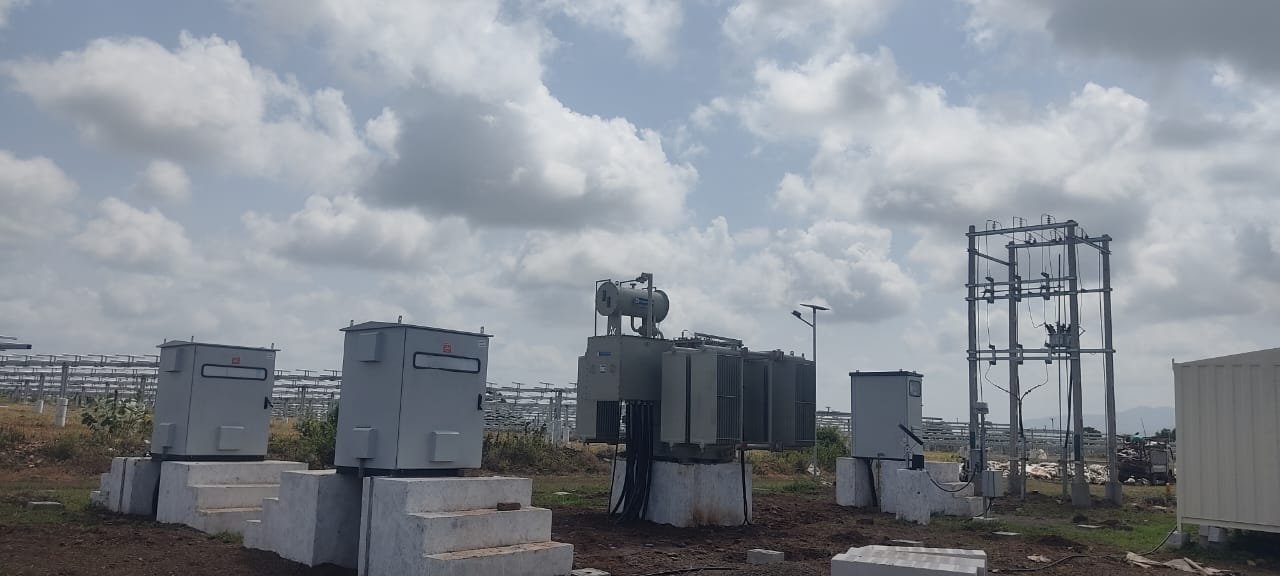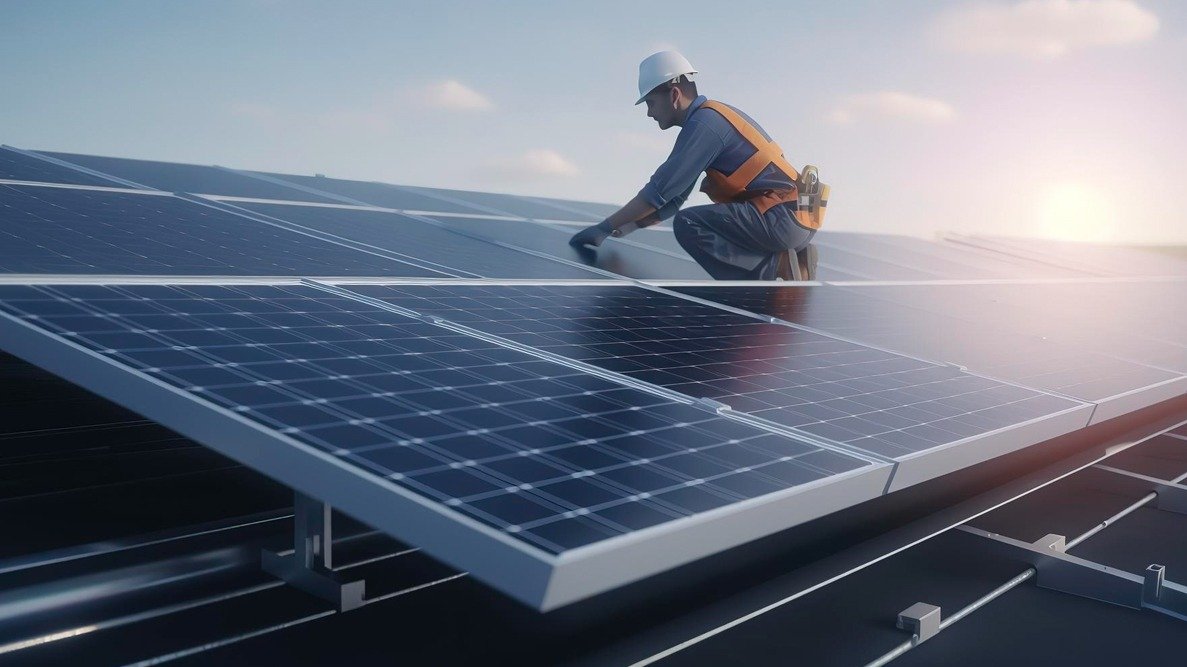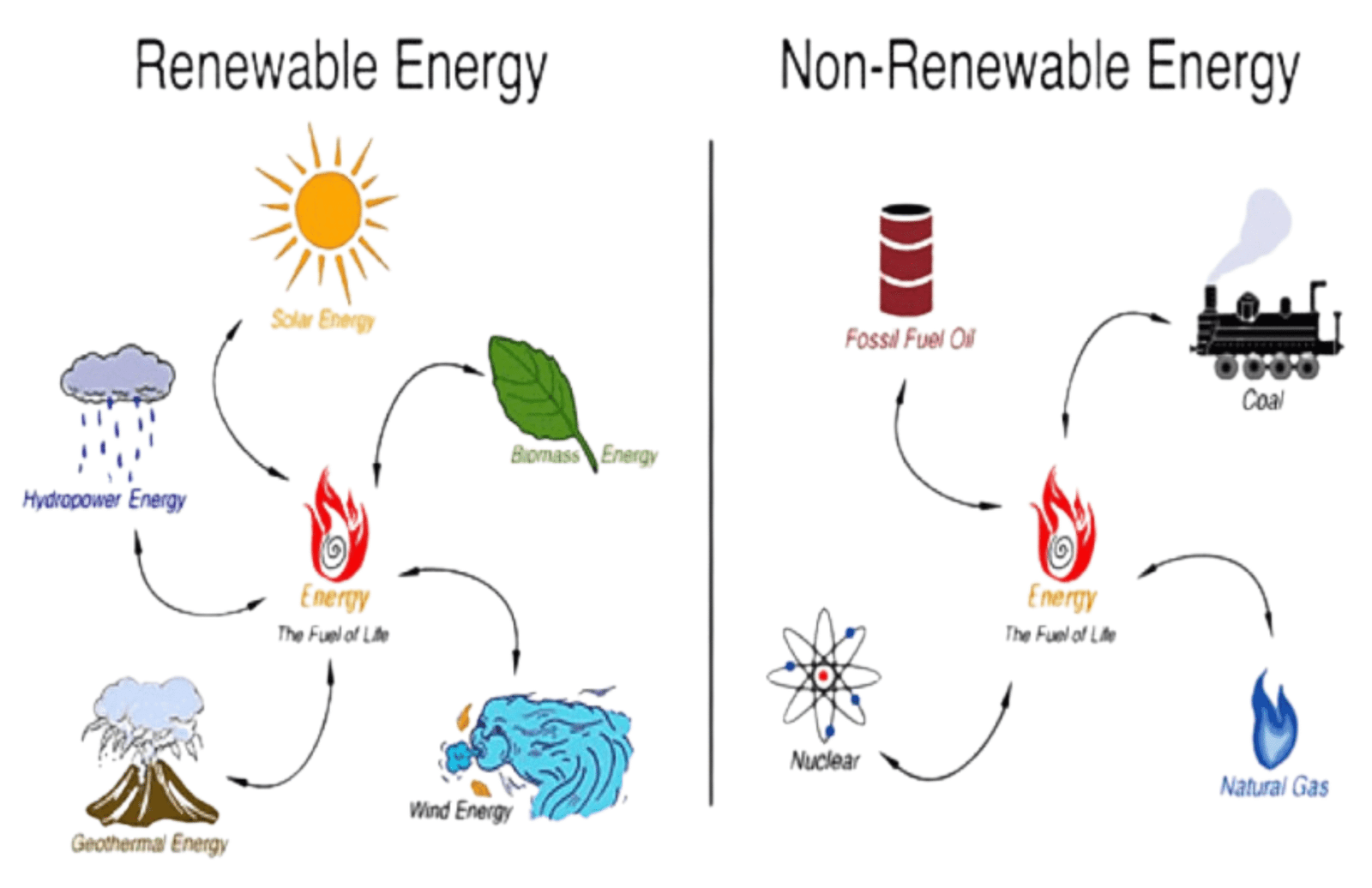The world’s demand for energy is growing faster than ever, and the question of whether we rely on renewable vs nonrenewable energy has become central to our planet’s future. As industries expand, populations grow, and technology advances, we face a choice: continue consuming finite resources or transition to sustainable power solutions. Understanding the differences, advantages, challenges, and implications of these two categories of energy is essential for businesses, governments, and individuals alike.
Table of Contents
What Is Renewable Energy?
Renewable energy in India refers to electricity generated from naturally replenishing, non-fossil fuel sources such as solar, wind, hydropower (including small hydro), biomass, and bio-power. These clean sources are central to India’s strategy for sustainable growth, energy security, and climate resilience.
Installed Capacity & Graowth Milestones
As of February–March 2025, India’s total non-fossil fuel capacity (renewables + large hydro + nuclear) reached 222.86 GW, making up 47% of the nation’s total installed power capacity.
-
- Installed renewable capacity (excluding large hydro and nuclear): ~220 GW—a record-breaking figure.
-
- Annual growth: In FY 2024–25 alone, 25 GW of renewable capacity was added—the highest in India’s history.
Breakdown by Energy Source (as of early 2025)
-
- Solar Power: ~100–105 GW
-
- Surpassed the 100 GW milestone early in 2025, achieving ~100.33 GW by January.
-
- Solar Power: ~100–105 GW
-
- Wind Energy: ~48–51 GW
-
- Hydropower (Large Hydro): ~47–52 GW
-
- Bio-power: ~11–11.5 GW
-
- Small Hydro: ~5–5.1 GW
-
- Nuclear Energy: ~8.18 GW included within non-fossil total.
What’s Driving This Momentum
-
- A record 24–25 GW of renewables added in FY 2024–25, with solar leading the way (adding ~20–24 GW) and wind growing steadily (~4 GW added).
-
- Solar manufacturing capabilities have skyrocketed—module capacity nearly doubled (38 GW → 74 GW) and PV cell capacity tripled (9 GW → 25 GW) in just one year.
-
- Policy support like the PM Surya Ghar Muft Bijli Yojana spurred ~3.3 GW of rooftop solar installations across more than a million homes.
-
- India’s renewable capacity nearly tripled in under a decade—from ~76 GW in 2014 to ~227 GW by mid-2025.
-
- The country now ranks 3rd globally in solar and 4th in wind capacity, according to IRENA’s 2025 data.

What Is Nonrenewable Energy?
Nonrenewable energy in India refers to power generated from finite, non-replenishing sources—primarily coal, lignite, natural gas, diesel, and nuclear. While renewables grow, nonrenewable energy remains essential for meeting the country’s high-demand, always-on industrial and residential needs.
Installed Capacity & Energy Mix (as of March 2025)
-
- Total installed power capacity: ~485 GW (as of June 2025).
-
- Non-fossil fuel capacity (renewables, large hydro, nuclear): ~242.8 GW, making up 50.1%—India surpassed its 2030 Paris target five years early.
-
- Fossil fuel capacity (coal, lignite, gas, diesel): ~242 GW, accounting for just under half of total capacity.
Breakdown of Nonrenewable Energy Sources
-
- Coal & Lignite (Thermal): Dominates the nonrenewable mix—largely responsible for India’s 240 GW of fossil-based power capacity.
-
- Natural Gas: A smaller segment, around 20 GW (about 4% of the total capacity).
-
- Diesel: Negligible share (~0.1%)—used mainly for backup or remote areas.
-
- Nuclear Energy: At ~8.8 GW—nonrenewable but low carbon—contributes ~1.8% of total capacity; 11 more reactors are under construction.
Renewable vs Nonrenewable Energy: Key Differences
| Aspect | Renewable Energy | Nonrenewable Energy |
|---|---|---|
| Definition | Energy from sources that naturally replenish within a short time (e.g., solar, wind, hydro). | Energy from finite sources that take millions of years to form (e.g., coal, oil, natural gas). |
| Examples | Solar, wind, hydropower, biomass, geothermal. | Coal, crude oil, natural gas, uranium. |
| Resource Availability | Abundant and naturally replenished. | Limited and will eventually run out. |
| Environmental Impact | Low emissions, minimal pollution, eco-friendly. | High greenhouse gas emissions, major contributor to climate change. |
| Cost Trends | Declining costs due to technology advancements; fuel is free. | Costs fluctuate based on extraction and market demand. |
| Reliability | Can be intermittent; storage or hybrid systems needed for consistency. | Highly reliable for constant baseload power. |
| Infrastructure | Requires newer technologies like smart grids and storage systems. | Established and widespread infrastructure. |
| Sustainability | Long-term sustainable for future generations. | Unsustainable in the long run due to depletion. |
| Global Ranking (India 2025) | India ranks 3rd in solar, 4th in wind capacity. | India among top coal producers and consumers globally. |

Environmental Impact
When comparing Renewable vs Nonrenewable Energy, it’s clear that their environmental footprints are vastly different. Understanding these differences is essential for industries aiming to meet sustainability goals, reduce emissions, and future-proof their operations.
| Aspect | Renewable Energy | Nonrenewable Energy |
|---|---|---|
| Greenhouse Gas Emissions | Very low lifecycle CO₂ emissions: wind ~7–38 g/kWh; solar ~44 g/kWh; nuclear ~10 g/kWh. | Extremely high emissions: coal ~1000 g/kWh; natural gas ~500 g/kWh — a major cause of climate change. |
| Air Pollution & Health | Clean operation, almost zero harmful pollutants. Very few related deaths per TWh (solar 0.02, wind 0.04). | Significant air pollutants (SO₂, NOₓ, PM), causing smog, respiratory illnesses, and higher mortality (~24.6 deaths/TWh for coal). |
| Water Use & Pollution | Minimal water use. Solar & wind require almost none; hydropower uses water without consuming it. | High water use in cooling and extraction; risks of contamination from spills and effluents. |
| Land & Habitat Impact | Requires more land per GW (solar 20–50 km²/GW; wind 50–150 km²/GW), but can be combined with farming (agrivoltaics). | Smaller direct land footprint but massive ecosystem loss from mining and drilling. |
| Lifecycle Waste | Low operational waste; solar panel recycling is possible, wind blades need better disposal solutions. | Generates ash, oil residues, and radioactive waste with complex disposal needs. |
| Climate & Ecological Health | Supports climate change mitigation and healthier ecosystems. | Accelerates global warming and environmental degradation. |
Economic Considerations
1. Levelized Cost of Electricity (LCOE)
The Renewable vs Nonrenewable Energy cost gap is widening.
-
- Renewable Energy: Solar and wind power are now significantly cheaper. Onshore wind is ~53% cheaper, and solar ~41% cheaper than the lowest-cost fossil alternatives. Solar’s LCOE is projected to drop to ₹1.6/kWh by 2030.
-
- Nonrenewable Energy: Coal costs ₹4.4–6.8/kWh, and prices are volatile due to fuel imports and policy shifts.
2. Hidden Savings and External Costs
In the Renewable vs Nonrenewable Energy debate, hidden costs matter. In 2024 alone, India saved nearly ₹4 lakh crore (~US$46 billion) through reduced fossil fuel imports, lower pollution, and decreased health-related expenses—benefits directly linked to renewable adoption.
3. Investment Trends
Renewable vs Nonrenewable Energy investment data shows a clear winner: renewables. Since 2014, over ₹5.2 lakh crore (~US$70 billion) has been invested in India’s renewable sector, including US$17.9 billion in FDI. Meanwhile, fossil fuel projects face declining investor interest due to ESG mandates and carbon risk.
4. ROI & Financial Stability
Financial studies comparing Renewable v. Nonrenewable Energy reveal that renewable projects in India deliver 12% higher annual returns, 20% less volatility, and 61% better risk-adjusted returns than fossil fuel investments.
5. Financing Challenges and Opportunities
While Renewable vs Nonrenewable Energy financing differs, renewables face higher upfront capital costs. However, policy incentives, falling technology prices, and battery cost reductions (down 93% since 2010) are closing the gap.
6. Storage & Grid Integration
Energy storage is the game-changer in the Renewable vs Nonrenewable Energy discussion. Studies show that by 2030, solar-plus-storage systems in Tamil Nadu could deliver electricity at ₹3.4/kWh—cheaper than coal.

Global Energy Consumption Trends
The world is undergoing a major transformation in how it generates and consumes power, making Renewable vs Nonrenewable Energy a central topic in global energy discussions. Over the past decade, consumption patterns have shifted dramatically, with renewable sources gaining momentum while fossil fuel dependence slowly declines.
1. The Shift in Global Energy Mix
The Renewable vs Nonrenewable Energy balance is evolving. In 2024, renewables accounted for around 30% of global electricity generation, up from just 20% in 2015. Nonrenewable sources—coal, oil, and natural gas—still supply the majority of total energy demand, but their market share is shrinking each year.
2. Regional Consumption Patterns
The Renewable vs Nonrenewable Energy split varies by region:
-
- Europe: Leads with over 40% of its electricity from renewables, driven by wind, solar, and hydropower.
-
- Asia-Pacific: Still heavily dependent on nonrenewables, especially coal, but also accounts for the largest share of new solar capacity.
-
- North America: Steady transition toward renewables, with natural gas still a dominant nonrenewable source.
3. Driving Forces Behind the Transition
The move from nonrenewables to renewables in the Renewable vs Nonrenewable Energy landscape is powered by falling costs of solar and wind, stricter environmental regulations, advancements in battery storage, and growing corporate commitments to net-zero targets.
4. Consumption Growth Rates
Globally, renewable energy consumption has been growing at an average of 7–9% per year, while nonrenewable energy consumption growth is slowing to below 1% annually. This trend suggests that in the Renewable vs Nonrenewable Energy competition, renewables are catching up fast.
5. Technology & Innovation Impact
Technological breakthroughs in efficiency, grid management, and storage are tilting the Renewable vs Nonrenewable Energy equation further toward clean energy dominance. Solar-plus-storage solutions are already competitive with coal in several regions.
6. Challenges in Global Transition
The Renewable vs. Nonrenewable Energy transition still faces challenges, such as intermittency issues for wind and solar, high initial investment needs, and infrastructure readiness in developing economies. Nonrenewables remain important for baseload power in many regions.
7. Outlook for 2030 and Beyond
By 2030, experts predict that renewables could supply 50% or more of the world’s electricity. The long-term Renewable vs Nonrenewable Energy trend indicates that fossil fuel consumption will decline steadily as nations commit to climate goals.
The Future of Energy
India’s energy trajectory over the next two decades paints a clear picture of shifting dynamics—seen vividly through the lens of Renewable vs Nonrenewable Energy. By 2030, Renewable vs Nonrenewable Energy projections show non-fossil fuel capacity soaring, with ambitious plans to hit 500 GW of renewables, while the share of coal in electricity generation is expected to fall below 50%.
The Renewable vs Nonrenewable Energy transition is bolstered by a robust policy ecosystem, from schemes like PM Surya Ghar Muft Bijli and the National Green Hydrogen Mission to bidding targets of 50 GW annually.Studies underline that Renewable vs Nonrenewable Energy growth will dramatically alter India’s power landscape—renewables (solar and wind) are projected to meet 66% of the increase in electricity generation by 2032, shifting the conversation from fossil-driven power to clean alternatives.
Survey data indicates that by 2047, non-fossil fuel sources could make up 61–65% of total installed capacity, with renewable energy expanding to as much as 1,819 GW in a net-zero scenario, while coal’s share limiting to 29–37%, reflecting the Renewable vs Nonrenewable Energy shift in both capacity and carbon emissions goals. Moreover, by 2047, Renewable vs Nonrenewable Energy will be further augmented by scaled-up nuclear (up to 12.5% of primary energy), offshore wind, and smart grid infrastructures, ensuring a cleaner, more resilient power system aligned with India’s net-zero goals

Role of Businesses in Energy Transition
The role of businesses in the energy transition, particularly in shaping the future of Renewable vs Nonrenewable Energy, has never been more critical. Across India, large industrial and commercial players are driving the shift toward clean power by investing in solar, wind, and hybrid projects, significantly reducing their dependence on coal and other fossil fuels. This transformation in the Renewable vs Nonrenewable Energy landscape is fueled by corporate power purchase agreements (PPAs), green financing tools like bonds, and strategic adoption of rooftop and open-access solar.
Leading companies are also collaborating with the government on initiatives that accelerate renewable deployment while gradually phasing out nonrenewable sources. Businesses are playing a dual role—cutting operational emissions to meet ESG targets and creating new revenue streams through renewable manufacturing, storage solutions, and green hydrogen production. As the Renewable vs Nonrenewable Energy mix shifts, industries are influencing policy reforms, enhancing grid integration with digital technologies, and building resilience against global energy price fluctuations. Ultimately, the active participation of Indian businesses is not just a matter of corporate responsibility—it’s the cornerstone of India’s journey toward a low-carbon, energy-secure future.
Challenges in Switching to Renewables
India’s energy transformation is promising, but the transition from nonrenewable to renewable energy comes with complex challenges. Here are the key hurdles:
-
- Stranded Projects & Regulatory Delays
Over 50 GW of renewable projects in India are now stranded—awarded through bids but lacking firm power purchase agreements (PPAs)—due to transmission bottlenecks, regulatory delays, and bureaucratic hurdles.
- Stranded Projects & Regulatory Delays
-
- Land Acquisition & Community Resistance
Acquiring land for large-scale solar or wind farms often leads to conflict. For example, Tata Power’s 100 MW solar project in Maharashtra faced severe protests from local farmers, illustrating how land disputes are slowing the energy transition.
- Land Acquisition & Community Resistance
-
- Grid Instability & Storage Shortages
India’s ambitious solar growth faces a significant obstacle: insufficient battery storage. Forecasts show India will require 336 GWh of storage by 2030, but only 82 GWh is projected by 2026–27. Without improved storage, renewables remain intermittent.
- Grid Instability & Storage Shortages
-
- High Upfront Costs & Weak Financial Support
Though renewable energy promises low running costs, its initial setup expenses—including land, infrastructure, and storage—remain high. Furthermore, pricing mechanisms and lack of long-term PPAs hamper investor confidence.
- High Upfront Costs & Weak Financial Support
-
- Grid Limitations & DISCOM Health
India’s power grid, designed for centralized thermal plants, struggles with large-scale renewable inputs. Additionally, stressed power distribution companies (DISCOMs) struggle to financially support and procure renewable power.
- Grid Limitations & DISCOM Health
-
- Supply Chain Dependencies
India’s heavy reliance on imported solar modules and battery components—mainly from China—exposes the transition to global supply chain vulnerabilities and import tariffs.
- Supply Chain Dependencies
-
- Social, Environmental & Workforce Transition
Transitioning from coal to clean energy affects livelihoods in coal-rich regions and raises concerns about equitable job displacement. Equipping workers with new skills and creating alternative employment are critical but complex tasks
- Social, Environmental & Workforce Transition
Frequently Asked Questions (FAQ)
1. What is the main difference between Renewable vs Nonrenewable Energy?
Renewable energy comes from naturally replenishing sources like solar, wind, hydro, and biomass, while nonrenewable energy comes from finite resources such as coal, oil, and natural gas. The key difference is that renewable energy can be sustained indefinitely, whereas nonrenewable sources will eventually deplete.
2. Why is switching from nonrenewable to renewable energy challenging in India?
Challenges include high upfront investment costs, land acquisition issues, grid infrastructure limitations, storage shortages, and policy uncertainties. These factors make the Renewable vs Nonrenewable Energy transition complex for both businesses and governments.
3. How does intermittency affect Renewable vs Nonrenewable Energy adoption?
Intermittency means renewable energy sources like solar and wind depend on weather and time of day, leading to fluctuations in supply. In contrast, nonrenewable energy sources provide constant output but at the cost of higher emissions and environmental impact.
4. What role do businesses play in the Renewable vs Nonrenewable Energy transition?
Businesses can lead the transition by investing in renewable technologies, improving energy efficiency, signing green power purchase agreements, and supporting local renewable manufacturing to reduce dependency on imports.
5. How can India overcome storage challenges in renewable energy?
India needs to expand battery storage capacity, invest in pumped hydro projects, and upgrade its power grid to handle intermittent renewable supply. These steps are critical to ensuring a stable and reliable renewable energy infrastructure.
Conclusion
The journey from nonrenewable to renewable energy in India is not a straight road—it’s a dynamic, complex transition shaped by economic, technological, regulatory, and social factors. While challenges like land acquisition disputes, storage limitations, and regulatory bottlenecks persist, the opportunities far outweigh the obstacles. Businesses that act now can secure energy cost stability, meet ESG commitments, and gain a competitive edge in a rapidly greening economy. The future of Renewable vs Nonrenewable Energy in India will be defined by those willing to innovate, invest, and lead.
At Soleos Energy, we partner with industries to overcome these challenges and unlock the full potential of renewable energy—whether it’s rooftop solar, ground-mount systems, or large-scale green energy solutions. If you’re ready to future-proof your operations and transition from nonrenewable to renewable energy with confidence, let’s start the conversation today. Contact us to explore custom solar solutions that reduce costs, cut emissions, and power your growth sustainably.
